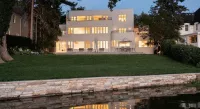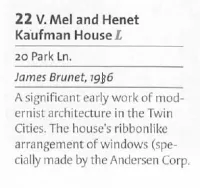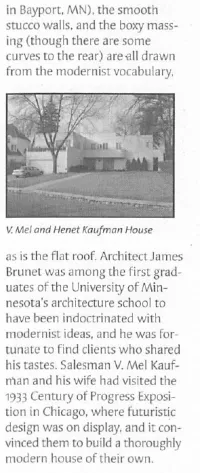Share what you know,
and discover more.
Share what you know,
and discover more.
Jan 01, 2009

-

- Charmaine Bantugan
20 Park Lane, Minneapolis, MN, USA
20 Park Ln. Home History James Brunet, 1936 A significant early work of modernist architecture in the Twin Cities. The house's ribbonlike arrangement of windows (specially made by the Andersen Corp. in Bayport, MN), the smooth stucco walls, and the boxy massing (though there are some curves to the rear) are all drawn from the modernist vocabulary, as is the flat roof. Architect James Brunet was among the first graduates of the University of Minnesota's architecture school to have been indoctrinated with modernist ideas, and he was fortunate to find clients who shared his tastes. Salesman V. Mel Kaufman and his wife had visited the 1933 Century of Progress Exposition in Chicago, where futuristic design was on display, and it convinced them to build a thoroughly modern house of their own. Citation: Millett, Larry. AIA Guide to the Minneapolis Lake District. Minnesota Historical Society Press, 2009.
20 Park Lane, Minneapolis, MN, USA
20 Park Ln. Home History James Brunet, 1936 A significant early work of modernist architecture in the Twin Cities. The house's ribbonlike arrangement of windows (specially made by the Andersen Corp. in Bayport, MN), the smooth stucco walls, and the boxy massing (though there are some curves to the rear) are all drawn from the modernist vocabulary, as is the flat roof. Architect James Brunet was among the first graduates of the University of Minnesota's architecture school to have been indoctrinated with modernist ideas, and he was fortunate to find clients who shared his tastes. Salesman V. Mel Kaufman and his wife had visited the 1933 Century of Progress Exposition in Chicago, where futuristic design was on display, and it convinced them to build a thoroughly modern house of their own. Citation: Millett, Larry. AIA Guide to the Minneapolis Lake District. Minnesota Historical Society Press, 2009.
Jan 01, 2009
20 Park Lane, Minneapolis, MN, USA
20 Park Ln. Home HistoryJames Brunet, 1936
A significant early work of modernist architecture in the Twin Cities. The house's ribbonlike arrangement of windows (specially made by the Andersen Corp.
in Bayport, MN), the smooth stucco walls, and the boxy massing (though there are some curves to the rear) are all drawn from the modernist vocabulary,
as is the flat roof. Architect James Brunet was among the first graduates of the University of Minnesota's architecture school to have been indoctrinated with modernist ideas, and he was fortunate to find clients who shared his tastes. Salesman V. Mel Kaufman and his wife had visited the 1933 Century of Progress Exposition in Chicago, where futuristic design was on display, and it convinced them to build a thoroughly modern house of their own.
Citation: Millett, Larry. AIA Guide to the Minneapolis Lake District. Minnesota Historical Society Press, 2009.
Posted Date
Sep 22, 2023
Historical Record Date
Jan 01, 2009
Source Name
AIA Guide to the Minneapolis Lake District
Delete Story
Are you sure you want to delete this story?












